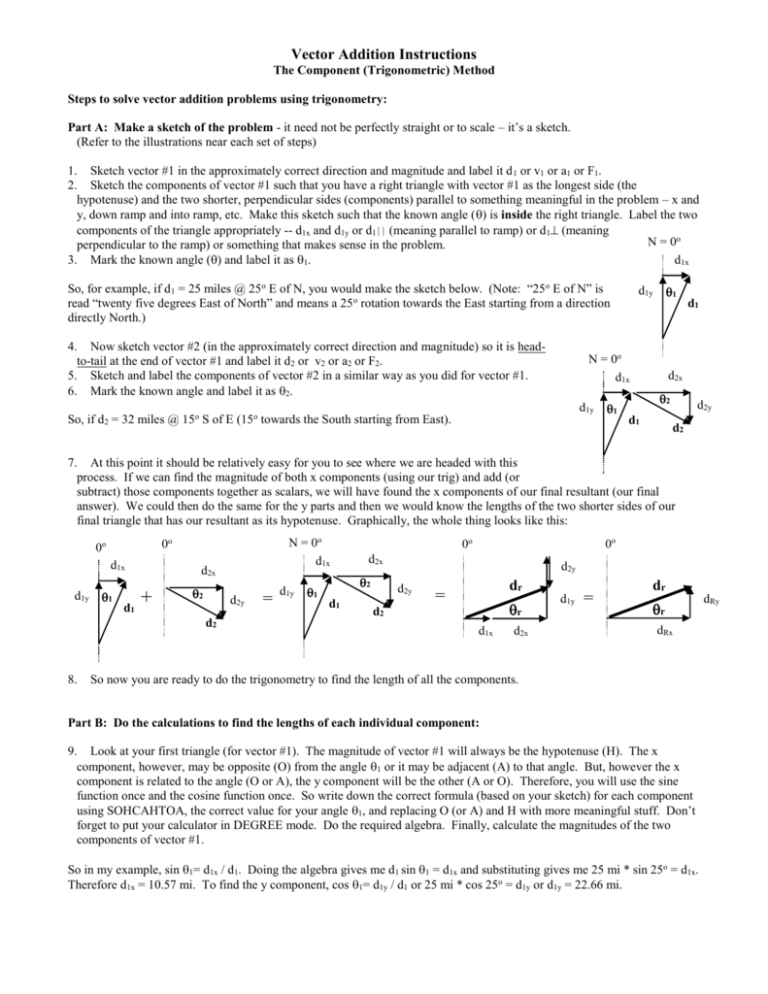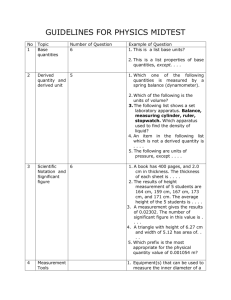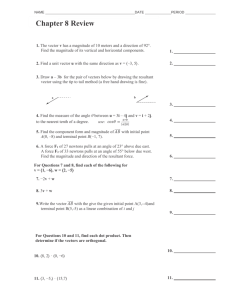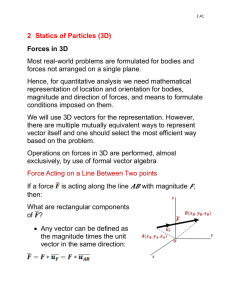Vector Addition Worksheet #2
advertisement

Vector Addition Instructions The Component (Trigonometric) Method Steps to solve vector addition problems using trigonometry: Part A: Make a sketch of the problem - it need not be perfectly straight or to scale – it’s a sketch. (Refer to the illustrations near each set of steps) 1. Sketch vector #1 in the approximately correct direction and magnitude and label it d 1 or v1 or a1 or F1. 2. Sketch the components of vector #1 such that you have a right triangle with vector #1 as the longest side (the hypotenuse) and the two shorter, perpendicular sides (components) parallel to something meaningful in the problem – x and y, down ramp and into ramp, etc. Make this sketch such that the known angle () is inside the right triangle. Label the two components of the triangle appropriately -- d1x and d1y or d1 (meaning parallel to ramp) or d1 (meaning N = 0o perpendicular to the ramp) or something that makes sense in the problem. 3. Mark the known angle () and label it as 1. d1x So, for example, if d1 = 25 miles @ 25o E of N, you would make the sketch below. (Note: “25o E of N” is read “twenty five degrees East of North” and means a 25 o rotation towards the East starting from a direction directly North.) 4. Now sketch vector #2 (in the approximately correct direction and magnitude) so it is headto-tail at the end of vector #1 and label it d2 or v2 or a2 or F2. 5. Sketch and label the components of vector #2 in a similar way as you did for vector #1. 6. Mark the known angle and label it as 2. o 1 d1y N = 0o d1x d1y o So, if d2 = 32 miles @ 15 S of E (15 towards the South starting from East). 1 d1 d2x 2 d1 d2y d2 7. At this point it should be relatively easy for you to see where we are headed with this process. If we can find the magnitude of both x components (using our trig) and add (or subtract) those components together as scalars, we will have found the x components of our final resultant (our final answer). We could then do the same for the y parts and then we would know the lengths of the two shorter sides of our final triangle that has our resultant as its hypotenuse. Graphically, the whole thing looks like this: d1x d1y 1 d1 d2x + 2 d2y d2 8. N = 0o d1x 0o 0o = d1y 1 d2x 2 d1 0o 0o d2y d2y dr = r d2 d1x d2x d1y = dr r dRx So now you are ready to do the trigonometry to find the length of all the components. Part B: Do the calculations to find the lengths of each individual component: 9. Look at your first triangle (for vector #1). The magnitude of vector #1 will always be the hypotenuse (H). The x component, however, may be opposite (O) from the angle 1 or it may be adjacent (A) to that angle. But, however the x component is related to the angle (O or A), the y component will be the other (A or O). Therefore, you will use the sine function once and the cosine function once. So write down the correct formula (based on your sketch) for each component using SOHCAHTOA, the correct value for your angle 1, and replacing O (or A) and H with more meaningful stuff. Don’t forget to put your calculator in DEGREE mode. Do the required algebra. Finally, calculate the magnitudes of the two components of vector #1. So in my example, sin 1= d1x / d1. Doing the algebra gives me d1 sin 1 = d1x and substituting gives me 25 mi * sin 25o = d1x. Therefore d1x = 10.57 mi. To find the y component, cos 1= d1y / d1 or 25 mi * cos 25o = d1y or d1y = 22.66 mi. dRy 10. Now look at your second triangle (for vector #2) and find the components in a similar fashion (use 2 and the magnitude of vector #2). You will again use the sine function once and the cosine function once. So for me here, cos 2 = d2x / d2 or 32 mi * cos 15o = d2x. Therefore d2x = 30.91 mi and d2y = 8.28 mi. 11. Special note: If you were adding three vectors together, you would just repeat the last step with vector #3 and extend the next part to add in the components of that third vector. Part C: Do the calculations to find the lengths of both components of the final resultant vector: 12. Calculate the x-component of the resultant vector by simple scalar addition -- i.e. drx = d1x + d2x. Make sure there are negative signs on the components where appropriate (make them match your sketch and some standard convention like “to the right is positive x”). For me, dRx = d1x + d2x = 10.57 mi + 30.91 mi = 41.48 mi. 13. Calculate the y-component of the resultant vector in a similar way -- i.e. dry = d1y + d2y. Again, make sure there are negative signs on the components where appropriate. For me, dRy = d1y - d2y = 22.66 mi – 8.28 mi = 14.38 mi. (Note the minus sign!) Part D: Make a sketch of the final resultant vector: 14. Sketch the overall x and y components head-to-tail. Pay particular attention to the directions (+x or –x direction for example) of these components. 15. Then sketch the resultant vector (the result of adding the original vectors #1 and #2) as a straight line from the tail of the first component in the “stack” directly to the head of the last component in the “stack” and label this resultant vector appropriately -- dr or vr or ar or Fr. 16. Last, label the direction of the resultant vector as angle r but make sure that r is inside the right triangle created by the two shorter, perpendicular components and the longer resultant hypotenuse. Also make sure that it N = 0o is clear what it is this angle is going to be calculated from (i.e. “r is being calculated relative to what?”). So in my example, even though North = 0 o, my r will be calculated relative to the positive x direction or East. dr r dRx Part E: Do the calculations to find the magnitude and direction of the final resultant vector: 17. Using the Pythagorean theorem (a2 + b2 = c2), find the magnitude of the resultant vector (i.e. drx2 + dry2 = dr2). Don’t forget that to solve for the magnitude of the resultant here, you must “undo” the square. This means you must take the square root of the sum of the squares. So I would write, dr2 = drx2 + dry2 or dr = (drx2 + dry2) or dr = ((41.48 mi)2 + (14.38 mi)2) or dr = 43.90 mi. 18. Using the tangent function, find the direction of the resultant vector. To do this, look at your last sketch and note which of the two shorter components is opposite and which is adjacent to the angle you’ve labeled. Recall that the tangent function relates O to A (i.e. tan r = opposite leg / adjacent leg). So you must first write down the correct formula. Then make the necessary alterations/substitutions. Next, do the algebra to solve for the angle r recalling that the inverse operation for any of the trig functions (that function that “undoes” them) is the inverse sin (SIN -1) or the inverse cosine (COS-1) or the inverse tangent (TAN-1). So, for me tan r = O/A or tan r = dry / drx or tan-1 r = dry / drx or r = tan-1 (dry / drx) or r = tan-1 (14.38 mi / 41.48 mi) and, with my calculator in DEGREE mode, r = 19.1o. 19. Lastly, restate your final answer giving the magnitude and the direction of the resultant vector. Don’t forget to include units and the proper number of significant figures on both the magnitude and the direction. Also make sure to include on your resultant angle an indication of the answer to that most basic of kinematics questions – “Relative to what?” In my case, I would write dR = 44 mi at 19o N of E. dRy







